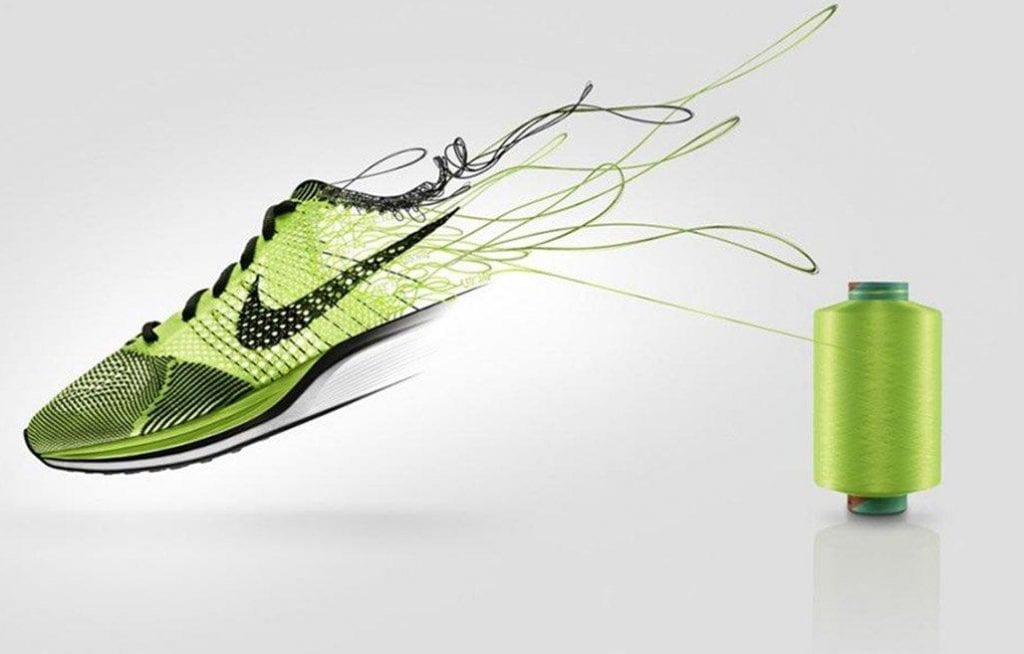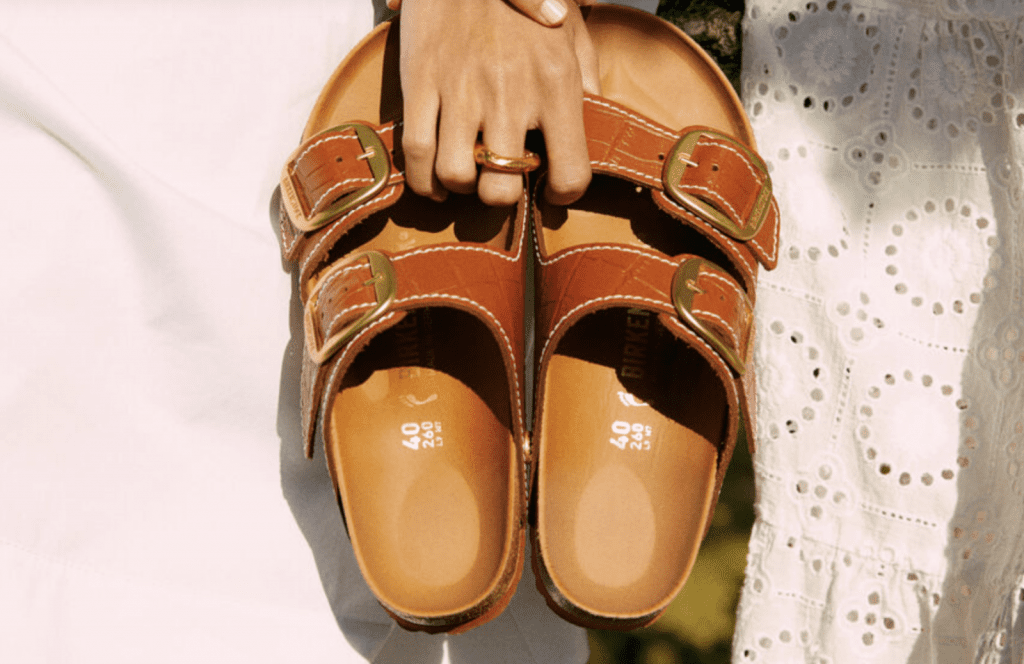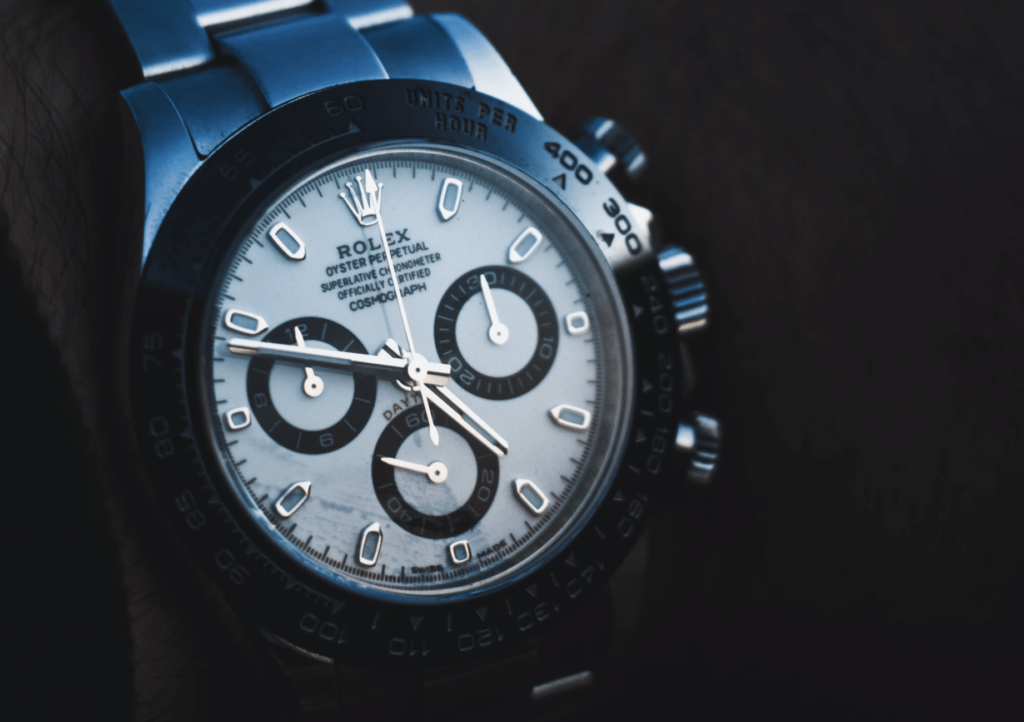At the onset of the new millennium, Nike set out to craft a shoe that would simultaneously deliver peak performance for athletes and enable it to reduce the large amount of waste that comes with the manufacturing of multi-part sneakers in the process. Inside Nike’s ultra-secretive Beaverton, Oregon headquarters, which require the signing of an iron-clad non-disclosure form to get past certain doors, the technology driving this shoe was the result of intensive research and development, and gave rise to expenses that CEO Mark Parker thought the $86 billion sportswear giant might never recoup. Yet, after nearly two decades, in February 2012, Nike debuted what was deemed to be the most momentous innovation in the fiercely competitive, and multibillion-dollar-earning sneaker market in years: the Flyknit.
The technology embodies in the shoe uses yarn and fabric variations to engineer “a featherweight, formfitting and virtually seamless upper.” In addition to “a precision fit,” the woven upper of Flyknit footwear – the first sneakers to bear an upper that consists of a single piece of material, as opposed to one derived from different pieces stitched together – results in little to no waste in the manufacturing process.
With roots at Nike that date back to at least 2000, when the Oregon-based sportswear giant made its very first prototype in working to create a sneaker with a woven-fabric upper, the technology represents “the right direction for Nike, from both a bottom-line and an environmental perspective,” Parker told the Wall Street Journal in 2015. And it has performed. In the first five years after its initial release, sneakers that bear the Flyknit technology brought in upwards of $1 billion in sales for Nike.
In reality, what Nike created was more than a consistently hot-selling sneakers; it also created a war, one that would cost hundreds of thousands – if not several millions – of dollars in attorneys fee and other legal costs, one that would stretch over years and continents, as within five months of the debut of the Nike Flyknit came another striking development: adidas unveiled knitted footwear of its own, Primeknit. Hailing the product as “a first-of-its-kind running shoe,” adidas’ Primeknit was born from a method that involves digitally knitting a single piece of fused yarn to create a single-thread upper and reduce material waste.
While James Carnes, adidas’ head of sport performance design, said at the time that the Primeknit had been in development for three years, and while adidas executives had, for some time, “been quietly telling a select number of footwear industry figures” about their own Primeknit technology, no one was prepared for what was to come … except maybe Nike.
“Adidas told me they were working on a similar technology to Flyknit,” trusted footwear analyst Matt Powell, told OregonLive, “but I had no idea it was this similar.” The likeness of the adidas’ shoe to that of its American rival’s Flyknit was unmistakable.
Adidas called its Primeknit shoe “one of [its] most exciting and sustainable products ever.” Nike called it a copy.
Battle of the Titans
“I am not surprised at the admiration – and the imitation – [the Flyknit] has generated,” Mark Parker told a crowd of shareholders at Nike’s annual meeting in 2012. In the wings, the sneaker juggernaut’s sizable legal team was readying for battle: adidas would soon be on the receiving end of a swift and strongly-worded lawsuit, not terribly unlike the 2006 suit that Nike filed against its archrival, claiming that it was making footwear using elements of patent-protected SHOX technology. The world’s largest sportswear company wanted adidas’ Primeknit footwear shut down and it wanted it done now.
Yes, almost immediately following the debut of adidas’ knitted footwear came a patent infringement lawsuit, filed in a District Court in Nuremberg, Germany, in which Nike sought to prohibit adidas from making and selling the Primeknit in Germany immediately, for the duration of the litigation and depending on the outcome of the case, permanently thereafter.
“Nike has a strong heritage of innovation and leadership in footwear design and development,” the company asserted in an official statement in conjunction with its lawsuit filing. “Our patents are the foundation of that leadership and we protect them vigorously.”
As for the choice of venue, Nike spokeswoman Mary Remuzzi said the case was filed in (and was limited in jurisdiction to) Germany because that was the only place where adidas was actually distributing the Primeknit at the time. Adidas had not yet begun distributing its new Primeknit-bearing footwear in the U.S. or other international markets, and if Nike was to have its way, it never would.
In August 2012, just days after the closing ceremony of the London Olympics – where both brands’ knitted footwear was on display – the District Court in Nuremberg granted Nike’s request for a temporary injunction, ordering adidas to immediately halt the production, marketing, and sale of its allegedly infringing knitted sneaker.
While it appeared that the case might be a home run for the American giant (given the court’s willingness to side with Nike initially), that win was short-lived. Adidas retaliated: It argued before the court that the construction technique that underlies both its footwear and that of its rival had been used since 1940s, and thus, was not proprietary to Nike.
In doing so, adidas’ legal team not only challenged the merit of Nike’s allegations, but more importantly, it called foul on the validity of Nike’s European patent (no. EP 1 571 938 B1), and it was victorious. Shortly thereafter, upon closer examination, the court declared that it would set aside the injunction, and ultimately, agreed with adidas’ assertion regarding the novelty of the knitting process.
As a result, the court invalidated Nike’s patent, holding that its design process failed to meet the novelty element required for patentability, thereby stripping Nike of the right to continue to pursue adidas for patent infringement. The ruling also meant that adidas could legally manufacture its own shoes bearing knitted elements in Germany.
But the battle of the titans was far from over.
No End in Sight
By the end of 2012, both Nike and adidas had begun selling their respective knitted footwear in the U.S. Almost certainly expecting Nike to inevitably file a similar patent infringement lawsuit in the U.S. (where its Flyknit-related patents were still valid and in effect) to prevent it from continuing to sell its knitted shoes stateside, adidas decided to take legal action of its own.
Looking to hit Nike where it would hurt the most, adidas sought to invalidate a number of Nike’s Flyknit-related patents, asking the U.S. Patent Trial and Appeal Board (“PTAB”) to review at least four of Nike’s U.S. patents for the Flyknit design and technology.
In one such matter, which is still currently pending in light of a back-and-forth legal battle, adidas argued that one of Nike’s U.S. patents for the Flyknit design (patent no. 7,347,011) is invalid, as similar methods have been set forth in others’ patents, including one that was filed in 1991 for a process to create uppers that are cut from a web of textile material and then shaped and connected to a sole.
After suffering a loss before the PTAB, Nike filed a 118-page appeal before the U.S. Court of Appeals for the Federal Circuit in 2014, arguing that it, in fact, “invented” the “novel” knitted technology, that the knit is recognized as a “quantum leap in the field.” (Note: The Federal Circuit Court would end up sending the matter back to the PTAB to determine whether the Flyknit would be considered patentable; siding with Nike in October 2017, the PTAB upheld its patent. Unsatisfied, adidas has since filed an appeal of its own with the Federal Court of Appeals).
Just as Nike was preparing to file its appeal in 2014, another striking battle erupted between the two giants, one that offered a remarkably telling peek into the true depth of the rivalry between Nike and adidas.
Meanwhile, An Inside Job
In December 2014, Nike filed an explosive $10 million-plus lawsuit against three of its former top design directors, claiming that, together, they conspired to steal millions of dollars’ worth of confidential information from Nike after being lured to adidas, where they would help create a brand-new Brooklyn-based design studio to truly rival Nike’s top-secret Innovation Kitchen.
In its 50-page complaint, Nike alleged that Denis Dekovic, Marc Dolce and Mark Miner had jumped ship to adidas in violation of their explicit non-compete agreements, taking with them a “treasure trove” of Nike’s “most important and highly confidential” information, which was procured, in part, to the defendants allegedly faking a broken Nike-owned laptop, from which all of the contents were copied. To seal the deal, Dekovic, Dolce, and Miner allegedly scrubbed their e-mails and text messages which, Nike’s counsel argued, served to obstruct the availability of “evidence of their betrayals.”
Nike further contended that Dekovic, Dolce, and Miner began plotting their departure in April 2014, pitching their studio plan (one that Nike claimed was merely a knockoff of its existing design studio) to Adidas and subsequently bringing Adidas information about Nike’s plans for the next several years in connection with its running, sportswear and soccer lines. In return, adidas reportedly – in an attempt to overthrow the giant – offered them lucrative employment contracts to jump ship from Nike.
Adidas also, according to Nike’s complaint, agreed to provide Dekovic, Dolce, and Miner with legal support and cover the legal fees “if ever Nike discovered their disloyalty and deception.”
In response to Nike’s downright damning allegations, the three designers filed counterclaims against Nike, accusing the company of creating a “culture of distrust and intimidation,” which caused them to seek employment elsewhere; hacking their phones, emails and social media accounts, and filing this “meritless” lawsuit purely as a “publicity stunt.”
That notably ugly suit was resolved easily enough by June 2015 – six months after its initiation – “through a confidential settlement” on the eve of the scheduled deposition of Nike CEO Mark Parker. Dekovic, Dolce, and Miner have since begun work at adidas, which opened its Brooklyn Creator Farm in the summer of 2017.
It is here, in what Highsnobiety’s Jonathan Sawyer called “a fairly secret warehouse location in Greenpoint,” that “you will find a relatively small conglomerate of designers from all across the globe, whose job is to ‘create culture,’ according to Dolce, [who is now] a VP and creative director at adidas.”
A Larger Fight
This legal battle was, nonetheless, a significant one. Considered in connection with the oft-ongoing patent battles between Nike and adidas, it provided a rare look at the profundity of the contention between the titans of the world’s $250 billion-plus sportswear industry.
It was also a noteworthy reminder that each separate Nike v. adidas legal battle (or vice versa) is merely an individual part of a much larger power play, one that plainly establishes that if there is a modern-day rivalry of the greatest proportions, Nike vs. adidas is certainly in the running for a top spot – one “stolen” employee and/or “copied” knitted shoe at a time.











